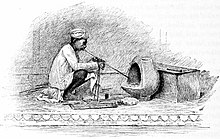This is an old revision of this page, as edited by MRINAL52 (talk | contribs) at 19:10, 30 August 2019 (Fixed typo). The present address (URL) is a permanent link to this revision, which may differ significantly from the current revision.
Revision as of 19:10, 30 August 2019 by MRINAL52 (talk | contribs) (Fixed typo)(diff) ← Previous revision | Latest revision (diff) | Newer revision → (diff)

Sunar (alternately Suniar(eh), Sonar or Swarnkar) is a Hindu caste in India and Nepal referring to the community of people who work as goldsmiths. Though the community is primarily Hindu, some members in the states of Haryana and Punjab are Sikh.
Though they are the traditional goldsmiths of North India, now many are also landowners, involved in cultivation, as well as selling grocery. However, their main occupation remains the manufacture and selling of jewellery. Members of the community are also involved in pawnbroking and moneylending.
Etymology
The term Sunar may derive from the Sanskrit suvarna kār, "worker in gold".
Status in society

Sunars all across India are classified into various groups. In Rajasthan, Punjab & Haryana some Sunars are called Mair Rajput, they are basically not goldsmith but later adopted this occupation. They falls under Forward Caste but they don't marry in other Sunars. In Haryana, Sunars are even divided into two segments, the Hindu Sunar and the Sikh Sunar. These two groupings are further divided into the Baari Sunar and the Shudre Sunar. Some Khatris also adopted this occupation and were called Khatri Sunars. All these groups are strictly endogamous, and practice clan exogamy. These divisions are further divided into clans, known as gotras. The Sunar are still involved in their traditional occupation, that is being goldsmiths. There is however a steady process in taking up other occupations, and the community in Haryana as whole is fairly successful, having produced several professionals.
Sunars in India are considered among Other Backward Class and are mostly workers of workshops in jewellery showrooms and agriculturists. Though after implementation of Mandal Commission their socio-economic condition changed overnight and today they have a good representation in Govt. offices, MNCs & PSUs.
Sunars in Nepal are part of Kami caste, which is also called Bishwakarma. Sunars in Nepal are considered as untouchables and are one of the serviceable castes of Nepalese society. They go through various caste discriminations in rural regions of Nepal and are among most deprived communities of Nepal.
Sunars in South India are called Panchal or Vishwakarmacaste which was first mentioned by census administrator & anthropologist, John Henry Hutton recorded in 1931 as a caste. It was a result of social upward mobility and they claimed themselves as descendents of Lord Vishwakarman, a Brahmin.
But according to community's historian's book - Bharatiya Viswakarmajar:Edava Somanathan:Analytical study of the Indus Valley Civilisation, it says that Sunars or Vishwakarmas are part of Indus Valley Civilization and they were in India before the arrival of Brahmins.
Factions
The Sunars are divided into a large number of territorial and non-territorial groupings called "alla". Some of the major alla are the Santanpuriya, Dekhalantiya, Mundaha, Bhigahiya, Samuhiya, Chilliya, Katiliya Kalidarwa, Naubastwal, Berehele, Gedehiya, Shahpuriya, Mathureke Paliya and Nimkheriya. Each lineage is associated with a particular area. To which its ancestors belonged to. The Sunar use Soni, Seth, Swarnkar, Shah, Bhutani, Bagga, Rudhra ,Babbar, Verma etc. as their surnames in Punjab. In Haryana, Rajasthan and Gujarat, the community is also known as Soni, Swarnkar. In Bihar, Uttar Pradesh, Madhya Pradesh, Jharkhand the Sunars are often known as Gupta, Soni, Kumar, Swarnkar, Sah and Verma, are their common surname.
See also
References
- People of India: Uttar Pradesh (Volume XLII) edited by A Hasan & J C Das page 1500 to 150
- People of India: Uttar Pradesh (Volume XLII) edited by A Hasan & J C Das page 1503
- R.V. Russell (October 1995). The Tribes and Castes of the Central Provinces of India. Vol. IV. Published Under the Orders of the Central Provinces Administration, Macmillan and Co., Limited St. Martin's Street, London. 1916. p. 517. Retrieved 6 July 2011.
- Maheshwari, Shriram (1991). The Mandal Commission and Mandalisation: A Critique. Concept Publishing Company. ISBN 9788170223382.
- Rowe, William L. (2007), "Mobility in the nineteenth-century caste system", Structure and Change in India Society (Reprinted ed.), Transaction Publishers, pp. 202–203, ISBN 9780202361383, retrieved 30 August 2019
- People of India: Haryana (Volume XXIII) edited by M.L Sharma and A.K Bhatia pages 475 to 479 Manohar Books
- "National Commission for Backward Classes". www.ncbc.nic.in. Retrieved 30 August 2019.
- देवरे, Shrawan Deore श्रवण (19 April 2018). "किन कारणों से पिछडे हैं ओबीसी?". फॉरवर्ड प्रेस (in Hindi). Retrieved 30 August 2019.
- "Kami (caste) - Misplaced Pages". en.m.wikipedia.org. Retrieved 30 August 2019.
- "Caste-based discrimination within Dalit community pose huge challenge in fight against casteism". kathmandupost.com. Retrieved 30 August 2019.
- People of India: Uttar Pradesh (Volume XLII) edited by A Hasan & J C Das page 1500
- People of India: Haryana (Volume XXIII) edited by M.L Sharma and A.K Bhatia page 475 Manohar Books
Further reading
- R.K. Gupta, S.R. Bakshi. Studies In Indian History: Rajasthan Through The Ages The Heritage Of Rajputs (set Of 5 Vols.). Sarup & Sons, 2008. ISBN 81-7625-841-5, ISBN 978-81-7625-841-8
Categories: